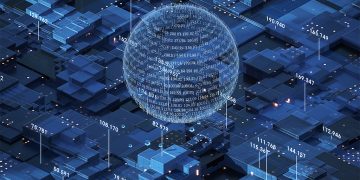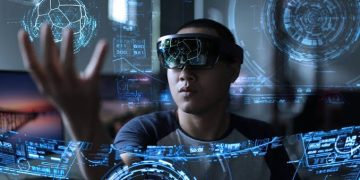Introduction
The vast expanse of deep space presents unique challenges for exploration, requiring innovative technologies to make human missions beyond Earth’s orbit feasible. The exploration of distant planets, moons, and other celestial bodies promises to unlock invaluable knowledge about our solar system and the universe at large. However, these missions also present a myriad of technical and logistical challenges, ranging from the need for advanced propulsion systems to sustainable life support systems for long-duration space travel. With the advent of new technologies, we are on the cusp of an exciting new era of space exploration. This article will explore the key technologies being developed for deep space exploration, including spacecraft propulsion, advanced life support systems, robotics and autonomous systems, and the solutions to challenges like deep-space communication and radiation protection.
Spacecraft Propulsion
Nuclear Thermal Propulsion: Its Potential to Drastically Reduce Travel Time to Mars and Other Destinations
One of the most exciting advancements in spacecraft propulsion is the development of nuclear thermal propulsion (NTP), which has the potential to revolutionize deep space travel. Unlike conventional chemical rockets, which rely on the combustion of fuel to generate thrust, nuclear thermal propulsion uses nuclear reactions to heat a propellant—typically hydrogen—to extremely high temperatures. This heated propellant is then expelled through a nozzle to generate thrust.
NTP offers several key advantages over traditional propulsion systems. First, it is significantly more efficient. The higher energy density of nuclear reactions means that NTP systems can produce much more thrust per unit of fuel compared to chemical rockets. This efficiency translates to faster travel times, which is especially crucial for missions to destinations like Mars, where a round-trip mission could take up to two years or more. With NTP, the travel time could be reduced to just a few months, allowing astronauts to reach their destinations faster, minimizing exposure to the harsh conditions of space.
In addition to reducing travel time, NTP could also make it possible to carry more cargo and supplies on long-duration missions, since less fuel would be needed for propulsion. This could be critical for the success of deep space missions, where astronauts would need to carry substantial supplies of food, water, and equipment for extended periods. The faster transit times enabled by NTP would also reduce the risk of radiation exposure and other health hazards associated with long-term space travel.
NASA and other space agencies have already conducted preliminary studies on NTP, and the technology is considered a promising candidate for future deep space missions. In fact, NASA’s Space Technology Mission Directorate is working on the development of a nuclear thermal rocket engine under the Nuclear Thermal Propulsion Program. If successful, this technology could pave the way for crewed missions to Mars and beyond.
Ion Thrusters: How Ion Propulsion Technology Is Used for Long-Duration Space Missions, Offering High Efficiency Over Long Periods
Another promising propulsion technology for deep space exploration is ion propulsion, which utilizes charged particles, or ions, to generate thrust. Unlike conventional chemical rockets that expel gases at high speeds, ion thrusters work by accelerating ions using electric fields and then expelling them at very high velocities. This process results in a much more efficient propulsion system that uses less fuel over long periods of time.
While ion thrusters do not generate as much thrust as chemical rockets, they are highly efficient in terms of fuel usage and can operate continuously for extended periods. This makes ion propulsion ideal for long-duration missions, such as those to distant planets or moons in our solar system. Ion thrusters have already been successfully used in several space missions, including NASA’s Dawn mission to explore the asteroid belt and the BepiColombo mission to study Mercury.
Ion propulsion systems can achieve much higher exhaust velocities than conventional rockets, allowing spacecraft to reach speeds that would be impossible with chemical propulsion alone. This makes them well-suited for missions where fuel efficiency is a priority, and long travel times are acceptable. For instance, an ion-powered spacecraft could be used for missions to explore the outer planets, such as Jupiter or Saturn, or to send probes to study distant objects in the Kuiper Belt and beyond.
The main challenge with ion propulsion is that it provides low thrust, meaning that it cannot be used for launch or for quick acceleration. However, for deep space missions, where travel times are measured in years rather than days or weeks, ion thrusters offer a unique advantage in terms of fuel efficiency and mission duration.
Advanced Life Support Systems
Closed-Loop Systems: Ensuring Self-Sustainability on Long Missions with Systems That Recycle Air, Water, and Food
One of the most critical challenges for deep space exploration is providing astronauts with the necessary resources to survive for extended periods without resupply from Earth. In the harsh, airless vacuum of space, human life support systems must be fully self-sustaining and capable of recycling vital resources like air, water, and food. The development of closed-loop life support systems is a key focus of space agencies and private companies looking to enable long-duration missions to the Moon, Mars, and beyond.
A closed-loop life support system is designed to minimize the need for external inputs by recycling air, water, and even waste. For example, water is purified and recycled for drinking, and the carbon dioxide exhaled by astronauts is scrubbed and converted back into breathable oxygen. Similarly, the oxygen system removes CO2 from the air, and waste materials such as human waste or food scraps are processed and turned into usable resources, such as fertilizers for growing crops in space.
NASA has been working on advanced life support systems for decades, with the goal of developing technologies that can support human life on Mars for extended periods. The Environmental Control and Life Support System (ECLSS) aboard the International Space Station (ISS) is one such example of a partially closed-loop system, but further advancements are needed to make these systems more efficient and robust for future deep space missions.
A key area of development is creating systems that can generate food in space. This involves growing plants in a controlled environment, such as a greenhouse aboard a spacecraft or lunar base, to provide astronauts with fresh, nutritious food. These systems must also be able to recycle organic waste into valuable resources like compost, which can then be used to grow new crops.

Artificial Gravity: The Development of Methods to Simulate Gravity in Spacecraft to Counteract the Negative Effects of Weightlessness on Human Health
Long-duration missions in microgravity environments, such as those aboard the ISS, have shown that prolonged exposure to weightlessness can have significant negative effects on human health. These effects include muscle atrophy, bone density loss, and cardiovascular issues. To address these challenges, scientists are investigating ways to simulate gravity in spacecraft, a concept known as artificial gravity.
One potential method for generating artificial gravity is by rotating a spacecraft or section of a spacecraft to create centrifugal force, which would simulate the effects of gravity. This could be achieved through a rotating habitat, such as a spinning wheel or cylindrical module, where astronauts would experience gravity-like forces as they are pushed against the walls of the rotating structure.
Although the technology for artificial gravity is still in the experimental phase, it is seen as a critical component for long-term missions to distant destinations, such as Mars, where astronauts will be exposed to microgravity for months or years. By creating artificial gravity, space agencies hope to mitigate the health risks associated with weightlessness, ensuring that astronauts can maintain their physical health during long-duration missions.
Robotics and Autonomous Systems
Autonomous Exploration: The Use of Robots to Explore Distant Moons and Planets, Such as Europa or Titan
Robotics and autonomous systems play a vital role in deep space exploration, especially in missions to explore distant planets, moons, and other celestial bodies that are beyond the reach of human explorers. These robotic systems can carry out tasks such as analyzing the surface composition of planets, collecting samples, and conducting experiments without the need for human intervention.
One of the most exciting prospects for robotic exploration is the potential for missions to distant moons, such as Europa (a moon of Jupiter) or Titan (a moon of Saturn). These moons are thought to harbor subsurface oceans that may contain the building blocks for life, making them prime targets for exploration. Robotic probes, such as NASA’s Europa Clipper mission, are designed to explore these moons and search for signs of habitability, without the need for humans to travel there.
In addition to exploring distant moons, autonomous rovers and drones are being developed to study the surface of planets and moons. These robotic systems can perform tasks such as geological surveys, sample collection, and even searching for life forms. By utilizing autonomous systems, space agencies can explore remote locations without risking human lives or relying on lengthy communication delays with Earth.
AI in Space Missions: How Artificial Intelligence Plays a Role in Decision-Making and Mission Management for Remote or Autonomous Operations
Artificial intelligence (AI) is increasingly being integrated into space missions to assist with decision-making, mission management, and autonomous operations. In deep space exploration, where communication delays can range from minutes to hours, AI can help make real-time decisions that ensure mission success.
AI can be used to monitor spacecraft systems, analyze scientific data, and make decisions about when and how to perform various tasks. For instance, AI could be used to autonomously control a rover exploring the surface of Mars, allowing it to navigate obstacles, identify interesting geological features, and collect data without needing instructions from Earth. Similarly, AI can assist in analyzing data from scientific instruments, identifying patterns or anomalies, and making recommendations for future experiments.
The use of AI in space missions reduces the reliance on Earth-based teams, making it possible to carry out more efficient and effective exploration in deep space. By combining AI with robotics and autonomous systems, space agencies can achieve more ambitious goals in deep space exploration.
Challenges and Solutions
Deep-Space Communication: Developing New Communication Methods to Maintain Contact Over Vast Distances
One of the biggest challenges in deep space exploration is maintaining reliable communication over vast distances. As spacecraft travel farther from Earth, the time it takes for signals to travel between Earth and the spacecraft increases, which can cause significant delays in communication. For example, it takes approximately 20 minutes for a signal to travel from Mars to Earth, and this delay can be even longer for spacecraft traveling to the outer planets.
To address these challenges, new communication methods are being developed, such as laser communication, which uses beams of light to transmit data at much higher speeds than traditional radio waves. Laser communication systems can transmit large amounts of data with lower power requirements and fewer delays, making them ideal for deep space missions. NASA has already successfully tested laser communication systems in space, and it is expected that these systems will become a standard tool for future deep space missions.
Radiation Protection: Technologies for Shielding Spacecraft from Cosmic and Solar Radiation
Radiation exposure is another significant challenge for deep space missions. Spacecraft traveling beyond Earth’s protective magnetic field are exposed to high levels of cosmic radiation and solar radiation, which can pose serious health risks to astronauts. To mitigate this risk, researchers are developing new radiation shielding technologies, including lightweight materials that can absorb or deflect radiation.
Additionally, spacecraft design is incorporating strategies such as placing sensitive equipment and crew habitats in areas that are shielded by thicker materials or built into the spacecraft’s structure. Ongoing research into radiation protection is crucial for the safety of astronauts on long-duration missions.
Conclusion
Deep space exploration represents one of humanity’s greatest challenges and aspirations. As we strive to explore new frontiers beyond Earth’s orbit, technological innovations in spacecraft propulsion, life support systems, robotics, AI, and communication are paving the way for groundbreaking discoveries. From reducing travel times to Mars to exploring distant moons like Europa and Titan, these technologies will enable humanity to push the boundaries of exploration and potentially unlock the mysteries of the universe. While challenges remain, the advancements being made today lay the foundation for future missions that will expand our understanding of space and our place within it.












































Discussion about this post